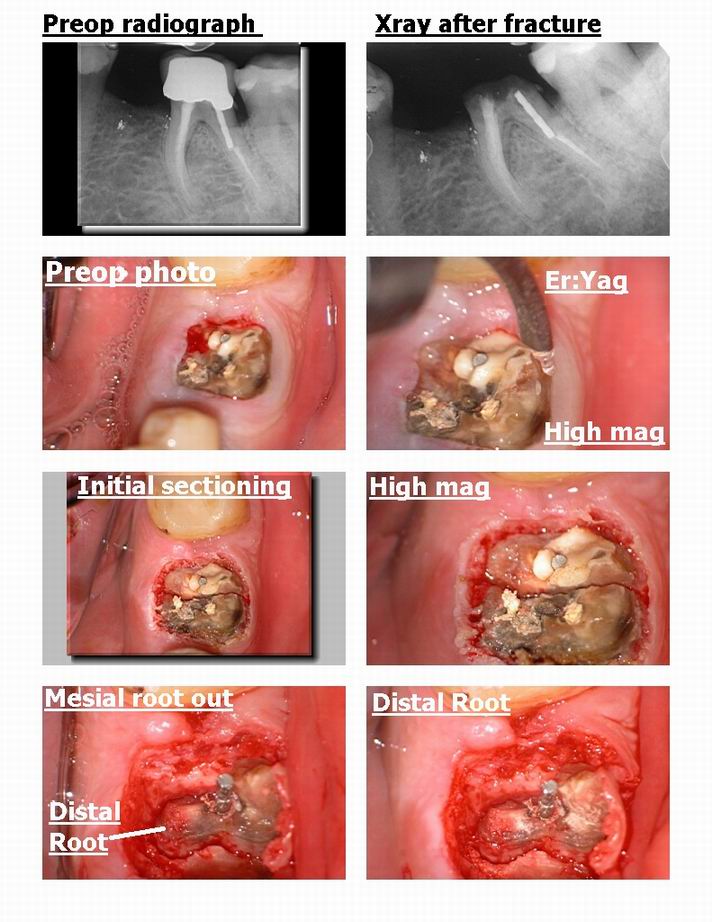Forums › Laser Treatment Tips and Techniques › Hard Tissue Procedures › Laser Assisted extraction of a molar
- This topic is empty.
-
AuthorPosts
-
Glenn van AsSpectatorHi folks: this was an interesting case for me because I was wrong in how it was going to work out, and because the laser was actually easier to use than the handpiece for visibility and access.
This patient had a crown on his tooth and broke it off, due to a number of reasons including financial and guarded prognosis he decided to have it extracted after the crown broke off.
I decided to use the erbium to trough around the tooth and also to split the tooth into two sections. I used the following ….
140 mj and 30 Hz for the tissue without water to reflect it back around the tooth, and then
160 mj and 30 Hz for the bone with water to create a trough circumferntially and finally
240 mj and 25 Hz with water for sectioning the tooth (you need higher energies in my opinion for dentin than bone).
I try to limit the air on the unit for bone relief, and what was weird is the mesial came out almost immediately.
The distal which I assumed would be easier because of the straightness of the root was more difficult. I had to go piece by piece till I got the last 5mm piece out.
I took some PA and photos along the way to show you the progress, but what was interesting is that the pen type grasp of the Delight Delivery system was acutally easier to get to the small tip at the end than my regular handpiece with a surgical length bur, which kept bumping into the adjacent teeth. I found this very interesting because I would have had to cut a flap and resect ALOT more bone if I had used the handpiece only.
Worked out well in the end but I thought it was interesting how I could get the laser into an area better than my traditional handpiece. In addition I didnt have a 400 micron tip, which is longer and thinner and would have been very useful for this exo where the roots were very very long.
Hope you like it.
Glenn


ASISpectatorHi Glenn,
Another well documented case. Thanks for sharing.
Do you think the soft tissue tip with the longer taper design will be appropriate to gain better reach for troughing to get the apical half of the distal root out?
I am not surprised that the distal is more of a challenge due to the angulation of the post. I have been guilty of placing post off angled and rendering the root structurally weakened on my fair share of teeth. Just hope this one wasn’t mine.
Andrew
(Edited by ASI at 1:04 am on Aug. 5, 2003)
Glenn van AsSpectatorHi Andrew: no worries about it being your case , it was mine from many years ago. Pt. doesnt have the best OH and had a real tough time with dependency issues a few years ago and his teeth took a beating during those days.
I am not big on the straight tip for these things as the troughing is so small that its tough to get anything in there. In fact I have told Hoya that for bone work a wider bigger tip might be in order.
I like your thinking about the length of the tip but it is so small at the end that the trough would be small.
I have used the 400 micron tip which is longer but again it is difficult to get much of an elevator in there , except a root tip elevator which I find works if the root is loose but otherwise not.
Its neat to see under the scope movement of the root tips, it really is quite obvious when it is ready tocome.
Its also great to be able to visualize the tip at all times.
It makes exos far easier and my assistant is able to see the tip from the monitor the whole time.
Thanks for the post…….
Glenn
PatricioSpectatorGlenn,
A great application of the laser. I hope I remember this post when I need to.
Pat
-
AuthorPosts
